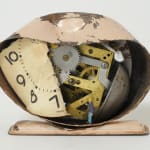


Liliana Porter Argentinian , b. 1941
Untitled (hook and string), 1973
silkscreen and string on paper, unique
20 3/4 x 25 1/2 inches
52.7 x 64.8 cm
52.7 x 64.8 cm
Further images
Once Porter became aware of what she called “the trap of technique” inherent in the printmaking tradition, she radically altered her practice. She sought images devoid of charged meanings, which...
Once Porter became aware of what she called “the trap of technique” inherent in the printmaking tradition, she radically altered her practice. She sought images devoid of charged meanings, which for her initially meant trivial objects like a small nail, a hook, or thread. Later, she chose even more immaterial elements, like the corner of a folded sheet of paper, a tiny wrinkle, or shadows.
“One explanation for these decisions might be that when I was a little girl I thought that the merchandise sold in hardware stores was free, because I couldn’t believe that people were actually supposed to pay money for things like a single nail,” Porter explains. “That must be why, subconsciously, I chose those materials. I couldn’t think of anything more trivial.”
Here a critical turning point occurs—a realization, simultaneously formal and conceptual, that would define her work from this point onward. By situating the object in an empty white space, she could remove all context and temporality. This abstract space opens a vast realm for reflection, in which meaning can be defined in an entirely different way.
“One explanation for these decisions might be that when I was a little girl I thought that the merchandise sold in hardware stores was free, because I couldn’t believe that people were actually supposed to pay money for things like a single nail,” Porter explains. “That must be why, subconsciously, I chose those materials. I couldn’t think of anything more trivial.”
Here a critical turning point occurs—a realization, simultaneously formal and conceptual, that would define her work from this point onward. By situating the object in an empty white space, she could remove all context and temporality. This abstract space opens a vast realm for reflection, in which meaning can be defined in an entirely different way.
9
of
9



